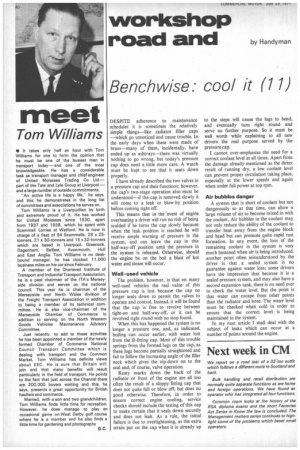workshop
Page 42

If you've noticed an error in this article please click here to report it so we can fix it.
road and by Handyman
Bench wise:
coo/ it (17)
DESPITE adherence to maintenance schedules it is sometimes the relatively simple things—like radiator filler caps —which go unnoticed and cause trouble. In the early days when these were made of brass—many of them, incidentally, have ended up as ashtrays—there was virtually nothing to go wrong, but today's pressure cap does need a little more care. A watch must be kept to see that it seats down properly.
I have already described the two valves in a pressure cap and their functions; however, the cap's two-stage operation also must be understood—if the cap is removed slowly it will come to a leak or blow-by position before coming right off.
This means that in the 'event of engine overheating a driver will run no risk of being scalded if he turns the cap slowly because when the leak position is reached he will receive ample warning of pressure in the system, and can leave the cap in this half-way-off_ position until the pressure in the system is released. Otherwise, should the engine be on the boil a blast of hot water and steam will occur.
Well -used vehicle
The problem. however, is that on many well-used vehicles the real value of this pressure cap is lost because the cap no longer seals down to permit the valves to operate and control. Instead, it will be found that the cap is free to revolve between tight-on and half-way-off, or it can be revolved right round with no stop found.
When this has happened the system is no longer a pressure one, and, as indicated, boiling can occur earlier, with water lost from the ill-fitting cap. Most of this trouble springs from the formed lugs on the cap, as these lugs become partially straightened and fail to follow the increasing angle of the filler neck which gives the nip-down on to the seal and, of course, valve operation.
Rusty marks down the back of the radiator or front of the engine are all too often the result of a sloppy fitting cap that does not quite fall or blow off, but does no good otherwise. Therefore, in order to ensure correct engine cooling, service checks should include the testing of this cap to make certain that it seals down securely and does not leak. As a rule. the initial failure is due to overtightening, as the extra strain put on the cap when it is already up to the steps will cause the lugs to bend, and eventually turn right round and serve no further purpose. So it must be well worth while explaining to all new drivers the real purpose served by the pressure cap.
I cannot over-emphasize the need for a correct coolant level at all times. Apart from the damage already mentioned as the direct result of running dry, a low coolant level can prevent proper circulation taking place, especially, at the lower speeds and again when under full power at top rpm.
Air bubbles danger
A system that is short of coolant but not dangerously so at that time, can allow a large volume of air to become mixed in with the coolant. Air bubbles in the coolant may not only reduce the ability of the coolant to transfer heat away from the engine block and head but can promote quite rapid rust formation. In any event, the loss of the remaining coolant in the system is very much hastened when air is being introduced. another point often misunderstood by the driver is that a sealed system is no guarantee against water loss; some drivers have the impression that because it is a sealed pressure system, and may also have a second expansion tank, there is no need ever to check the water level. But the point is that water can escape from other points than the radiator and hose. The water level must be checked when cold in order to ensure that the correct level is being maintained in the system.
In my next article I shall deal with the subject of leaks which can occur at a number of points around the engine.




























































































